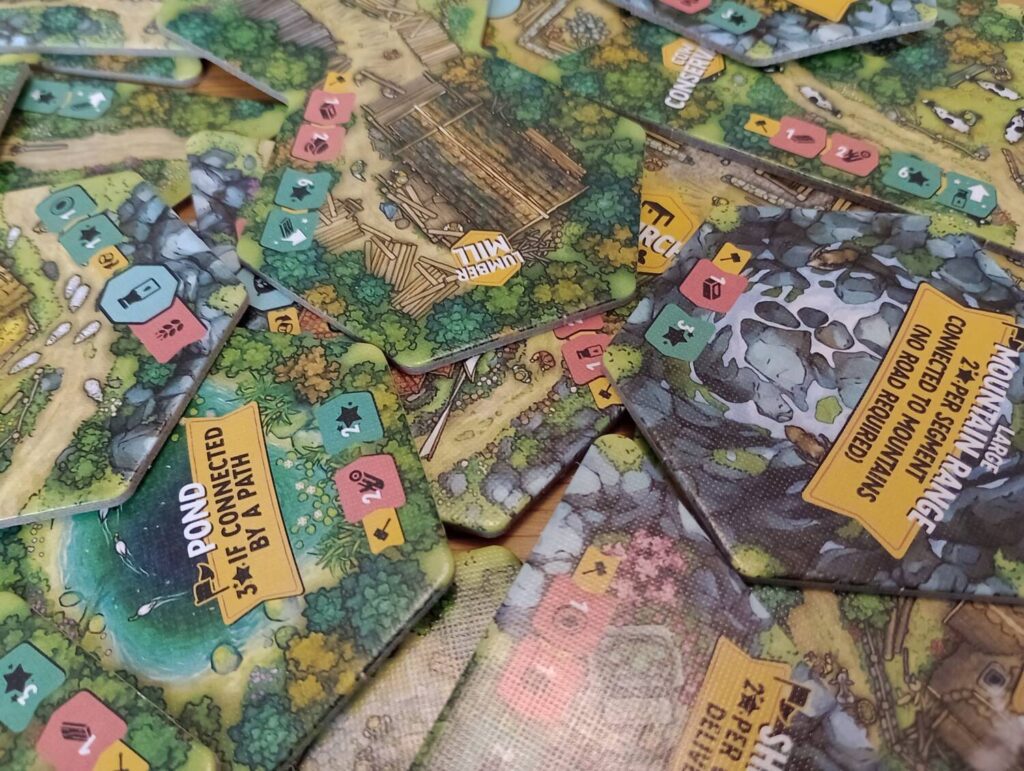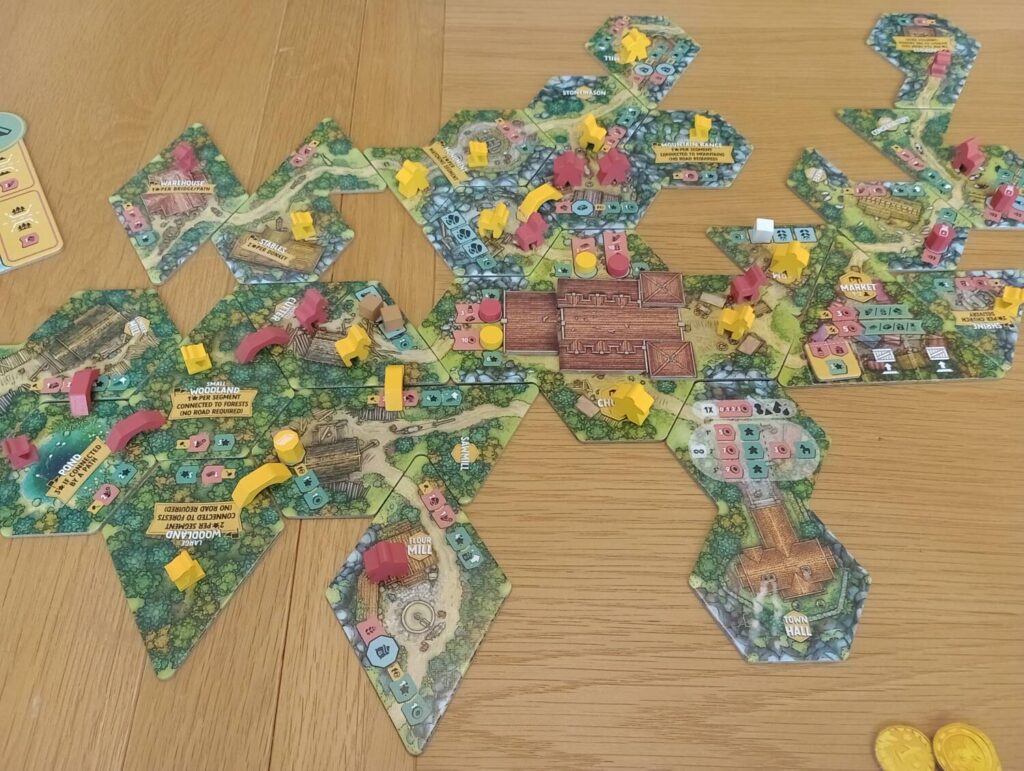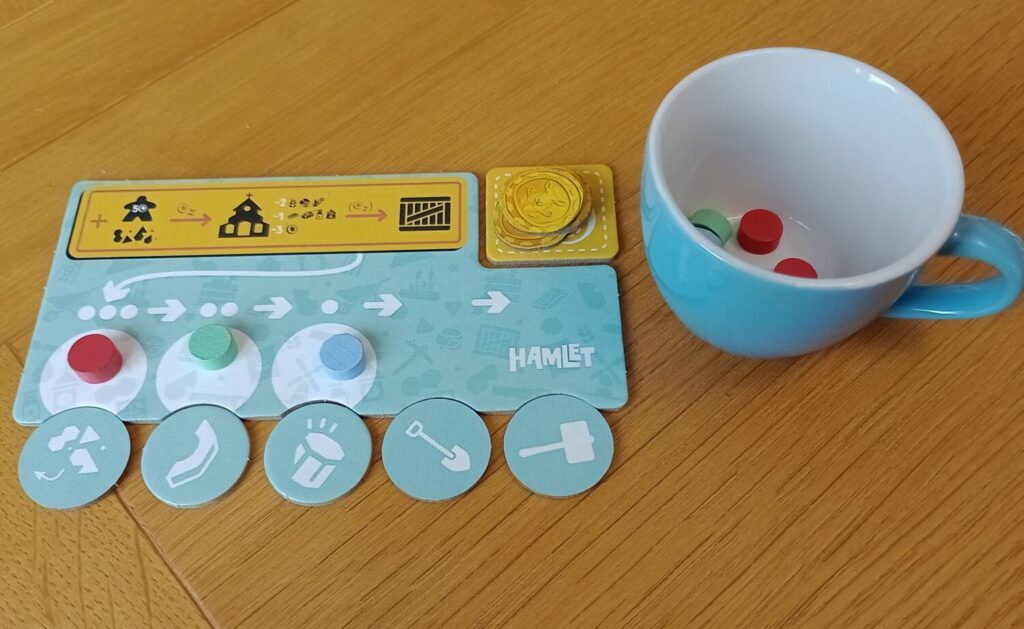Disclosure: Meeple Mountain received a free copy of this product in exchange for an honest, unbiased review. This review is not intended to be an endorsement.
I’m always fascinated by the way board games can create a sense of place that extends far beyond their cardboard components.
I’m not talking about narrative-based games that tell a story around a setting or legacy games which build up an environment over a series of sessions. What interests me is how games can build a sense of place through their mechanics alone, without the aid of characterful illustrations or paragraphs of text. Games that feel organic in the fictional communities they create.
For all my love of Carcassonne, and for all that you’re building a landscape of places and people, it never feels populated. Dice City, Machi Koro, Alhambra, Tiny Towns, Quadropolis, Ginkopolis, Sprawopolis and more – they all tackle the subject of building communities, but they never actually feel lived in.
Suburbia does it with the narratives that emerge from tile adjacency impacting population and income. Little Town’s direct geography creates unplanned pockets of industry and production sprouting up amongst the game’s natural features. Santa Monica’s occasional stretches of emptiness or dilapidation create spaces for cliques to congregate. The job roles in Villagers open further avenues for budding workers to arrive and flourish, communities attracting communities. Village’s setting comes to life through the progress of time and the fleetingness of life. That’s where grandad died, here’s where mum worked, there is the church where Burt spent his life in the dark.
Precious few games achieve this sense of place, but Hamlet, by designer David Chircop and publisher Mighty Boards, manages it with ease. I wish everything it did was as good.
Moke-r Placement
Your task in Hamlet is ostensibly to build a church, though in reality points are given from a variety of sources.
Hamlet’s story is that once the church is built your humble hamlet is now a town, which simultaneously skews the meaning of the term (a hamlet with a church is a village) and ignores the fact that at the start of the game your hamlet already has a Market and Town Hall.

Despite this already being the most developed hamlet in history, you achieve all this by moving your people around, sending them to produce and process materials, create roads, buildings and landmarks, sell goods at the market, build sections of the church, hire workers and purchase donkeys.
Ah, donkeys. Another of the game’s thematic fuzzy areas. Aside from money, all goods in Hamlet are communal – once created they’re left on the tile where they were made and can be used by anyone, so long as they can be transported to where they’re needed. Which is where the donkeys come in. Donkeys act as stepping stones, bouncing goods from tile to tile. It’s not even close to how a donkey would haul goods about the place but it’s a lovely system, prompting moreish mule machinations.
The game progresses, people and donkeys multiply, the hamlet grows, the church rises.
Words Are All I Have
If you asked me for a word to describe Hamlet, I would say ‘cluttered’. If you pushed me for two words, I’d say ‘cluttered’ and ‘fiddly’. A third word might be ‘eye-straining’. A fourth ‘stodgy’. ‘Chaotic’ and ‘awkward’ would follow soon after. The words ‘interesting’, ‘compelling’ and even ‘enjoyable’ would feature in an ongoing list of descriptors but they’d be more like afterthoughts.
I admire a lot of what Hamlet attempts. I even like some of it. But cluttered, fiddly, eye-straining, stodgy, chaotic and awkward are the Top 6 words I’d reach for. The combination of those words is tiresome and sometimes headache-inducing. If Hamlet were a person, then I doubt we’d be friends no matter how much I might respect them.

Sparks And Sputters
Recently I’ve found myself getting frustrated by games that get in their own way. Games that do something great and then bury it under extraneous guff. Games where production and/or design decisions extinguish the spark of joy.
And Hamlet could be a veritable sparkler – there’s a lot to like here.
The tile shapes are outstanding. Using arrangements of triangles, they’re like nothing else out there. Continuously interesting. The impact of their unusual shapes is a game where the resulting settlement is as higgledy-piggledy as in real life. Gorgeous and glorious, they force awkward placements and lengthy journeys. Hamlet looks spectacular.
But the focus on tile art comes at the expense of legibility – some tiles have 3 building/production tracks on them and might also house several meeple, donkeys and/or resources. All of which are too small (and printing white on yellow is a visual crime). And whilst I love the winding paths and odd connections between tiles, it makes seeing which tiles are actually connected to each other surprisingly tricky, especially when those production tracks are sometimes printed across the paths. The visual clutter is too much, at times it’s unpleasant. Arguably Hamlet’s greatest strength (those tiles and what players do with them) creates its greatest weakness (a hard to parse gaming area).

The way tiles are added to the general pool is also excellent. As tiles are built that produce new refined goods like timber or bricks, a fresh batch of possible tiles is added to the bag. It’s reminiscent of the branching trade avenues of Villagers, although in Hamlet, there’s no logic why you need to be able to produce milk to be able to build a Windmill or flour to build a Master Stonemason (presumably it’s their premises you’re building, not they themselves).
It’s a shame then that shuffling those tiles in the bag is awkward as anything. The deluxe version has chits drawn from a bag and those chits should have been standard. In fact, they should have been standard and the chits could have held the costs and rewards of building each tile, instead of them being on the tile: Pull a chit from the bag, find the tile and place it in the market with the chit. Discard the chit once the tile is built. There, I’ve just cut the visual clutter by a third and made selecting tiles at random an easier process for all.
Anyway, back to the potential sparks.
The communal goods aspect of the game is a great idea, bringing home the idea that everyone is working to build this church together. Chircop used the phrase ‘emergent economy’ and the game is more interesting for it. If I use a good that you refined, then you get a bonus – it’s excellent! But the goods on the board compound the visual clutter of the playing area, and they contribute to some of the biggest gameplay problems I have with Hamlet.
Going Full Eeyore
You see, Hamlet is a wonderfully interactive affair. Everyone is bustling about creating and using goods here and there. But, if I create some goods ready in preparation for my next turn, and then you and Jill use those goods on your turns (potentially even sneaking what I’d planned out from under me), well, that really sucks for me. True, I should have planned better (although more on that later), but it also creates a situation of not wanting to leave your opponents in a position where they can swoop in with little effort and achieve something. The game can drag, becoming sludgy as players try not to leave low hanging fruit ripe for the picking.
The only sensible way to avoid this is to get more workers, giving you more things you can do on your turn. Despite what it says in the rulebook, this is the dominant strategy for the early game (and has resulted in at least one player feeling hard done by because they were last in turn order and so couldn’t raise funds for workers as quickly as the other three players). Once you have three workers you’ve more control each turn, but the delay between your turns lengthens.

The board state also changes so much due to the communal nature of the resources that it’s hard to plan turns in advance. Earlier I talked about needing to plan better, but there’s only so much you can foresee. Will you need to go and create some bricks because another player has used them, or will they still be there on your turn waiting for you? Player turns, and as a result the game itself, can stretch interminably whilst you figure out your actions whilst navigating the tangled mess that is the growing settlement.
That stodginess is accentuated by the plethora of Landmark tiles that clog the bag from the start, giving points for doing various things. They’re interesting but heavily dilute the chances of ‘useful’ tiles (refineries, warehouses) being drawn (and it’s the ‘useful’ tiles which drive the game forward). Everyone races to build the first of each refinery type which only exacerbates the problem, adding proportionally more Landmark tiles to the bag. Of the 26 tiles that can be pulled from the bag during the game, 16 are landmarks, useful for scoring only.
This creates an uneven tempo and occasional problems with Hamlet’s arc. When the only blueprints available to buy early in the game are Landmarks, which has happened in about 80% of my games, Hamlet feels stagnant. When the third or fourth refinery type still hasn’t emerged from the bag as you cross into the second half of the game, you start to feel like something might have gone wrong.
And don’t get me started on when this happens in a solo game – you might spend 20 minutes waiting for the irritating and slightly fiddly ‘Botric’ to build the tiles it’s hanging on to and open up the second half of the game. In one game I purposefully left the stone supply full so that ‘Botric’ would have materials with which to build one of the two refineries it was holding.

Recognising the issue around refineries not emerging from the bag, Chircop and team have ensured that the new tiles added with each ‘unlocked’ refinery type also include one other refinery type. But this leads to the strange milk/flour and windmill/master stonemason thematic discord mentioned previously.
My patience, like the market, runs out too quickly. Not that I’d want the market to have more tiles – that would simply elongate the game further. But most games feel like they’re past their best around the time the last market tile is taken. After that, Hamlet’s effort-to-gains ratio tips too far the wrong way. Some players have ended up completing the church, not for the point gains (which are decent but feel like they should be more significant) but just to end the game.
‘It’s not much of a tail, but I’m sort of attached to it’
That’s a lot of negativity for a game many people love. And it’s possible, with a few games under your belt, to push past some of these issues. There are some interesting things going on here and with the right players and a mixed draw of tiles the game can tick along at a decent (though still too long) rate. But, like a vampire forsaking human blood, it’s never fully satisfying. The elements that are most interesting are downplayed by all those Landmark tiles and the visual clutter never goes away. Ultimately, that sucks all the joy from the game for me.

It’s such a shame because it promises so much. Like his earlier designs The Pursuit of Happiness, Petrichor, and …and then, we held hands., Hamlet shows that Chircop is a designer to keep an eye on, someone interested in exploring the potential of board games, the stories they can tell and the feelings they can evoke. As Bob Pazehoski said in his fascinating interview with Chircop last year, “David has a knack for keeping eyes on the table and creating engaging, interactive spaces”. Despite not being completely enamoured with Hamlet, I’m looking forward to what Chircop designs next.
Irrespective of its flaws, Hamlet excels at creating a sense of place, a fictional community inhabiting the odd geography of the game. The way your village grows unevenly, its weird wonkiness is perfect. Without trying, your imagination fills in the gaps left between tiles, populating this uneven collection of buildings with people, interactions and stories. That’s worth something in my book, even if I don’t feel the need to visit again.












Add Comment